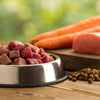What to Mix with Raw Dog Food: Elevate Your Pet's Diet for Optimal Health
- Houndsy
Table of Contents
- Introduction
- The Benefits of Raw Dog Food
- What to Mix with Raw Dog Food: Essential Add-Ons
- Crafting a Balanced Raw Dog Food Meal
- Addressing Common Concerns
- Conclusion
- FAQ Section
Introduction
Did you know that nearly 70% of dog owners are concerned about their pet's diet and nutrition? As passionate pet parents, we always seek the best options for our furry companions, and that often leads us to considering a raw dog food diet. However, venturing into the world of raw feeding can feel daunting—especially when we wonder what to mix with raw dog food to create balanced, nutritional meals that contribute to our dog's health and happiness.
In this blog post, we will explore the ins and outs of enhancing raw dog food meals, focusing on the ingredients that can complement a raw diet effectively. We’ll discuss the benefits of raw feeding, how to ensure a balanced meal, and the ideal supplements or mix-ins to nurture your pet. By the end, you’ll have a comprehensive understanding of not just what to mix with raw dog food, but how to elevate your pet’s feeding experience overall.
So, grab a seat next to your pup, and let’s embark on this journey together!
The Benefits of Raw Dog Food
Before we dive into mixing ingredients, let’s discuss why raw dog food is increasingly popular among dog owners. Transitioning to a raw food diet can offer numerous benefits for our canine companions:
-
Nutrient-Dense: Raw diets typically consist of high-quality proteins, vitamins, and minerals essential for your dog’s health. Ingredients like muscle meat, organs, and bones provide a wealth of nutrients that may not be as bioavailable in processed kibble.
-
Better Digestion: Many pet owners report improved digestion, healthier stools, and less flatulence when switching to a raw diet. This is likely due to the natural enzymes and moisture in raw food, allowing for better nutrient absorption.
-
Shinier Coat and Healthier Skin: Raw diets rich in fatty acids, particularly from sources like fish, can lead to healthier skin and a glossier coat. Furthermore, the absence of fillers and artificial ingredients contributes to overall skin health.
-
Increased Energy: Owners often observe a boost in their pets' energy levels when they switch to raw feeding, likely due to the nutrient quality. Dogs receiving balanced, raw nutrition tend to be more active and playful.
-
Customized Nutrition: With homemade raw dog food, we control what goes into our dog's meals, allowing us to tailor their diet to specific needs, whether our dog is allergic to certain ingredients or has unique dietary requirements.
What to Mix with Raw Dog Food: Essential Add-Ons
When it comes to making raw dog food truly well-rounded, there are multiple ingredients we can incorporate to enhance both nutritional value and flavor. Here are our top considerations and suggestions:
1. Fresh Fruits and Vegetables
Incorporating fresh produce is key. Fruits and vegetables provide essential vitamins, minerals, and antioxidants that can amplify your dog’s immune system while introducing new textures into their meals. Here are some top choices:
- Carrots: Excellent for healthy eyesight and dental health; they can also be grated into Kibble.
- Pumpkin: Rich in fiber and great for digestion; it can help with both constipation and diarrhea.
- Blueberries: High in antioxidants, these tiny fruits can aid in fighting inflammation and improving cognitive function.
- Spinach: Packed with vitamins A, B, C, and K, but should be given in moderation due to oxalic acid.
- Apples: A crunchy snack packed with vitamins, but remember to remove the seeds!
Blending or finely chopping these ingredients aids in nutrient absorption since dogs naturally struggle to break down plant cellulose.
2. High-Quality Proteins
While the foundation of a raw diet is protein, adding different sources can diversify nutrients further. Consider these options:
- Eggs: A complete protein source, eggs can enhance a dog’s diet and provide biotin and fatty acids. They can be served raw or lightly cooked.
- Fish: Fatty fish like salmon or sardines are loaded with omega-3 fatty acids, promoting skin health and anti-inflammatory properties.
- Organ Meats: These should make up about 10% of your dog's total meal content. Liver, kidney, and heart offer concentrated vitamins and minerals, enhancing nutritional value.
3. Healthy Fats
Incorporating healthy fats is essential for maintaining energy and providing necessary fatty acids. Here are some excellent options:
- Coconut Oil: Known for its antimicrobial properties, coconut oil can improve skin health and coat condition when added to meals in moderation.
- Fish Oil: Rich in omega-3s which are crucial for heart health, joints, and immune system support. Consider options like salmon oil.
- Bone Broth: A delicious addition that also provides hydration and gut health benefits. It can be incorporated as a meal topper or mixed into dry food.
4. Supplements and Nutritional Boosters
Certain supplements can further elevate the nutritional profile of your dog’s diet. Consider including:
- Probiotics: Beneficial bacteria for gut health, these can improve digestion and overall immune function.
- Green Superfood Powders: Powders rich in chlorophyll, vitamins, and minerals can aid in detoxification and immune support.
- Chia Seeds: High in omega-3 fatty acids and soluble fiber, they can be fed whole or ground to aid digestion.
5. Carbohydrates (Optional)
While dogs are primarily carnivores, including certain carbohydrates can offer benefits, especially for working or active dogs that need more energy.
- Brown Rice or Quinoa: These grains can be included in small quantities for energy but are entirely optional and should not exceed 30% of the diet if included.
- Sweet Potatoes: A nutritious source of carbohydrates rich in vitamins, they can be cooked and mashed to create a wholesome addition.
6. Treats and Snacks
Homemade raw diets also allow us to get creative with treats. Instead of store-bought options, consider making treats yourself:
- Peanut Butter and Banana Bites: Just mash bananas with peanut butter, shape them into little bites or freeze for a refreshing treat.
- Frozen Yogurt Treats: Plain yogurt mixed with fruit can provide a cool snack for warmer days.
Crafting a Balanced Raw Dog Food Meal
Now that we have a wealth of ingredients to consider, the next step is to draft a balanced recipe for those raw dog food meals. A typical guideline is to aim for:
- 70-80% high-quality animal protein (include muscles, organs, and bones)
- 20-30% vegetables and fruits (opt for a mix to cover various vitamin needs)
- Optional carbohydrates if needed.
Example Ratio for a Balanced Meal
A simple balanced meal could include:
- 60% Protein: 40% ground beef, 20% chicken liver
- 20% Vegetables: 10% blended spinach, 5% carrots, 5% blueberries
- 20% Carbohydrates: 10% cooked quinoa, 10% mashed sweet potato
Always remember to adjust the ratios to fit your dog's size, weight, diet requirements, and activity levels. It is also worth consulting your veterinarian or a pet nutritionist to ensure that you are meeting your dog’s specific dietary needs.
Addressing Common Concerns
Is Raw Feeding Safe?
When considering what to mix with raw dog food, it’s vital to maintain hygiene and safety. Raw diets can harbor bacteria, so always prioritize safe food handling practices. For instance, freeze meats before using to eliminate parasites and ensure all surfaces and utensils are clean.
What About Nutritional Balance?
Feeding exclusively raw means we must ensure all necessary vitamins and minerals are accounted for. Nutritional deficiencies can lead to health issues, so periodically reviewing your dog's health and diet with a veterinarian is crucial.
Conclusion
Mixing different components into your dog’s raw food can vastly improve their diet, enhance meal variety, and prevent nutritional deficiencies. Incorporating fresh fruits, vegetables, lean proteins, healthy fats, and thoughtful supplements allows us to create meals that contribute to our furry friends' health and happiness.
Just remember, transitioning to raw feeding doesn’t need to be overwhelming. Enjoy the process of finding what works best for your dog, taking care to monitor their health and adjust as needed.
As we continue to innovate and improve the feeding experience for our pets, consider the convenience and beauty of the Houndsy Kibble Dispenser for streamlined feeding. With its stylish design and ergonomic features, we can enhance the way we serve our beloved pets while maintaining the aesthetic of our homes. Explore our Houndsy Kibble Dispenser here.
FAQ Section
1. Can I mix raw dog food with kibble?
Yes, it is quite common to mix raw food with kibble. Just ensure that the raw portion does not exceed 20% of the total diet to maintain balance and avoid digestion issues.
2. How can I transition my dog to a raw diet?
Start by gradually introducing raw food into their meals. Mix small amounts of raw ingredients with their regular food and slowly increase the raw portion over a week or two while monitoring their response.
3. What are the risks of feeding raw dog food?
Potential risks include the presence of bacteria, imbalanced nutrition, and improper handling of raw ingredients. Always prioritize safe food handling and quality ingredients.
4. Is it necessary to add supplements to raw dog food?
While not always necessary, supplements can help fill in gaps if some nutrients are not obtainable through your selected ingredients or to cater to specific health conditions.
5. How often should I feed my dog raw food?
Raw feeding frequency often depends on your dog's size and nutritional needs. Many owners choose to feed their dogs twice daily, but serving suggestions from a vet or pet nutritionist tailored to your dog's specific needs is recommended.
6. Can I use leftover table scraps in raw dog food?
Using leftover table scraps is generally not recommended unless you are sure they are dog-safe and nutritionally appropriate. Things like onions, garlic, and certain spices can be harmful to dogs. Always consult a vet if in doubt.
By thoughtfully incorporating these ingredients and elements into our dog’s meals, we can truly enhance their wellbeing, ensuring they lead long, joyful lives. Happy feeding!













